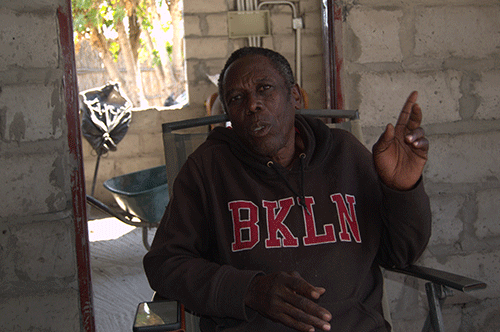CHIMCHIMANI – Recognised war veteran, Bothman Sikute, born and bred in the Kanono area of the Zambezi region feels their sacrifices in and outside Namibia during the liberation struggle for independence have been forgotten by the government as they continue to suffer in poverty.
Although Sikute was fortunate to get a teaching job after independence, he said it was a little bit too late to work for many years and gather a reasonable pension as they spent most of their youth in exile.
However, he bemoaned that the fruits of independence are not enjoyed by many of them who tirelessly fought for Namibia’s independence.
Sikute shared thrilling stories on how he survived many battles at various training camps and other People’s Liberation Army of Namibia (Plan) military bases in areas such as Oshatotwa in Zambia.
Due to the political situation in Namibia in the 1960s and 1970s, Sikute decided to abandon his teaching job in 1975 and crossed into Zambia at the tender age of 22 with others.
Others he crossed with include the likes of Bollen Sankwasa [former Zambezi police commander], Ernest Puzeli, Starlife Munyandi, Francis Kabende, and Lawrence Kabende.
He then underwent military training and fought in guerilla battles in Angola and Zambia where he sustained injuries that left him permanent bomb sprinter scars on his back and legs.
Unfortunately, after 33 years of Namibia’s independence, Sikute joins the chorus of many other war veterans countrywide who continue to languish in poverty while they sacrificed their youth for the liberation struggle. “I sacrificed for this country. I suffered for this country. I sacrificed my whole youth in exile. Some of them are now enjoying more than us while they used to beat us as they were working with the enemy. My two kids are just there. One is a security guard. Imagine a war veteran’s son to become a security guard. The other one is just roaming around the village. It’s a shame. I am struggling now. I can’t survive on N$6 000. We need to be assisted. Some of my comrades are in the villages without legs,” Sikute, who is the headman of the Kanono area, expressed.
Sikute said that several battles they participated in during the struggle for independence from 1966 to 1989 were never heard of, documented, nor featured in any of the annually commemorated national holidays.
He recalled on 11 July 1976, the South African army attacked them while at the Swapo camp at Shatotwa in Zambia where lives were lost and many injured.
“I survived many battles. We had a barrack for girls. Even Doreen Sioka was in there. We didn’t have guns to fight only shikumbwatis [knobkerries]. I was with my nephew and we ran to the east. I was injured by a mortar splinter on my leg. People lost their lives especially those who were in the first barrack. They put up bomb traps where we used to collect water. Some of the guys were injured and lost their legs. It is believed about 15 people died in that battle,” he narrated.
As a trained reconnaissance person, Sikute and others were tasked to cross back into Namibia after the bombing of Cassinga in Angola.
“We wanted to revenge what happened in Cassinga. In 1978, we also attacked them in Katima,” he said.
In 1979, Sikute went for anti-aircraft training and he was a commander at the time in that unit.
In 1980, he went to Angola where he received another training as a nurse.
During the guerrilla war in Angola, he suffered other injuries on his back and legs. Up until 1989, he went to Lubango and returned to Namibia on 13 July.
Home affairs minister Albert Kawana, who is also a war veteran, paid homage to those who died during the war of national liberation struggle of Namibia.
In particular, he expressed gratitude that the people of Namibia will forever be grateful to the people of Zambia for their unwavering support during the struggle for the liberation of Namibia.
“This area was a war zone during the armed struggle for the liberation of Namibia. This was part of the eastern front where many battles took place. We still remember Kalongola area, which is not far from here, where we used to cross the Zambezi River on the way to the training camps and other Plan military bases in the areas such as Oshatotwa, Sinjembela, and Imusho before crossing into Zambezi region, then Caprivi, to engage the South African apartheid colonial army,” Kawana noted.
He confirmed some of the South African colonial military bases were located in this area and were destroyed.
In revenge, Kawana said the South African army resorted to killing civilians, both here in Namibia and Zambia.
“Indeed even the Sesheke Secondary School across the Zambezi River was not spared. It was bombed by the South African jet fighters. Zambian immigration officials, a stone’s throw from here were killed in cold blood, although this border was closed due to the war. Many Zambian civilians were killed in cold blood,” he said.
–anakale@nepc.com.na


